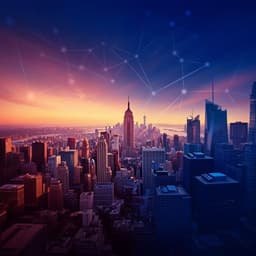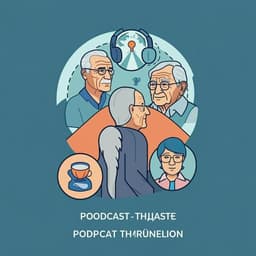
Humanities
Historical sensing: the spatial pattern of soundscape occurrences recorded in poems between the Tang and the Qing Dynasties amid urbanization
H. Lin, J. Wang, et al.
Dive into a captivating exploration of Fuzhou's cultural heritage through the lens of poetry! This study reveals how urban green spaces resonate with historical auditory sensations, particularly the charming chirping of birds. Discover insights from researchers Hanzheng Lin, Jia-Bing Wang, Xuewei Zhang, Fangbing Hu, Jiang Liu, and Xin-Chen Hong.
~3 min • Beginner • English
Introduction
The study investigates how urban heritage and historical soundscapes, especially those embedded in urban forests, are represented and can be rediscovered through classical Chinese poems about Fuzhou (SE China). Urban heritage spans monumental sites, everyday communal spaces, and contemporary urban elements and is assessed through physical form, cultural-historical associations, and vitality. Soundscapes, considered part of intangible cultural heritage and linked to health and identity, are ephemeral and vulnerable to urbanization. Fuzhou’s rapid development has eroded distinctive cultural characteristics and threatened heritage and ecological environments. The research aims to reassess the vitality of Fuzhou’s urban culture for heritage conservation and urban regeneration, providing methodological and practical insights for planning and marketing. It proposes “historical sensing,” adapted from social sensing, to analyze poets’ experiences of locales and sounds across dynasties, mapping the spatial distribution of poetized locales and identifying preferences by time and place. Challenges include scattered and uneven historical records, linguistic interpretation issues, possible discrepancies between poetic description and reality, and historical toponyms misaligned with current names and locations.
Literature Review
Soundscape in poems: Prior work connects historical sounds (e.g., industrial traffic, wartime sirens, vendors’ calls, church bells) with memory, identity, and socio-spatial power. Literary analyses show soundscapes shape sensory perception, reveal hidden landscapes, and encode power, status, and social issues. However, links between literary soundscapes and contemporary urban development and heritage preservation are often underexplored. Historical and cultural heritage in poems and maps: Poems and prose encode rich spatiotemporal information useful for understanding urban heritage distribution, management, and tourism branding; ancient maps document urban form evolution, toponymy, and concentrations of heritage and related soundscapes. Urbanization and noise have diminished many historic soundscapes, leaving textual traces; thus, poem-based excavation is critical. Social sensing and historical sensing: Social sensing captures environmental and social awareness via modern big data, but historical contexts lack such platforms. Compiled historical texts can reconstruct past senses of place. The study coins “historical sensing” to analyze past locales and soundscapes, bridging literary sources and spatial analysis to evaluate vegetation coverage, soundscape preferences across dynasties, poets’ locational tendencies, and conservation of locales and soundscapes.
Methodology
Approach: Geographical text analysis integrates literary sources with spatial analysis to infer ancient travel tendencies and soundscape preferences. Study area: Central Fuzhou (Gulou, Taijiang, Cangshan, Jin’an Districts), a mountainous estuarine basin with long cultural history and high forest coverage. Historical city extents across dynasties (Han through Qing) were reconstructed from ancient maps and chronicles to contextualize poet movements. Urban zone classification: Inner city, suburb, and exurb were delineated using mapped walls for each dynasty and a 25-minute horse-carriage isochrone (speed 6 km/h) centered near historic city cores (Tang Hujie Gate/Song Huanzhu Gate, modern Dongjiekou area). Data sources: (1) Poems from five compilations focused on Fuzhou/Fujian; (2) Eight ancient maps depicting Fuzhou’s walls and urban form. Data processing steps (per the research flow): - Step 1 (collection): 413 poems gathered from 5 collections; 8 maps selected. - Step 2 (processing): 115 poems selected that met criteria; 56 poetized locales identified; 25 soundscape types extracted and categorized (natural sounds, animal sounds, human life sounds including religious, mechanical/artificial sounds). - Step 3 (mapping/statistics): Poetized locales geolocated via titles/content and POIs; ancient walls digitized in QGIS; site preferences analyzed by distance zone, landscape type (natural vs cultural), and locale category; kernel density analysis and hydrological situation analysis performed. - Step 4 (field investigation): On-site photography and condition assessment of locales, classifying well-preserved (31) vs destroyed (25). Locale classification: Cultural landscapes included religious architecture (temples, towers) and nonreligious structures (bridges, pavilions, terraces, gardens). Natural landscapes included mountains, hills, lakes, rivers. Soundscape categorization (25 types): natural (river, wind, trees, water flow, rain), animal (birds, clucking, insects, monkeys), human life (Buddhist chanting, singing, reciting, amusement, reading, talking, roaring, footsteps, stepping on leaves), mechanical/artificial (instruments, bells, traffic, wind chimes, night watches, tea boiling, rod thumping). Mapping: Ancient city walls from Tang–Qing reconstructed from historical cartography; locales overlaid to assess spatiotemporal distribution and preservation context in relation to urban green spaces and forests.
Key Findings
- Distribution and greenery: Most poetized locales now lie within urban green spaces (parks, scenic areas) with good vegetation. Spatially, locales concentrate in Gulou, followed by Taijiang, Jin’an, and Cangshan. Overall, poets’ locales concentrate in inner city (38.1%) and exurbs (38.1%). - Landscape preferences: Poets favored cultural landscapes (61.3%), especially religious architecture (30.3%), and natural mountain landscapes (27.7%) such as Kushan, Wushan, Yushan, Pingshan. Preference for high forest coverage sites (mountains) aligns with frequent mentions of animal and natural sounds (notably birds). - Soundscapes overall (aggregate counts across dynasties): birds chirping (37), instruments (29), bell ringing (29), singing (20), water flowing (12), Buddhist chanting (10), river sounds (10), amusement (9), tree rustling (8), wind (5), talking (5), monkey screeching (5), insects (5), reciting (5), clucking (2), roaring (2), reading (2), traffic (2), footsteps (1), rod thumping (1), stepping on leaves (1), tea boiling (1), night watch (1), wind-bell (1), raining (1). - Soundscapes by dynasty (selected trends): Tang: birds dominant; Song: instruments and bell ringing frequent; Yuan: instrument sounds favored; Ming: richest variety, with birds (26), bells (24), instruments (15), singing (14), rivers (8), water flowing and amusement (7 each), plus natural and human sounds; Qing: birds and instruments most common (6 each), with additional natural sounds (water, wind) and some human activity sounds. - Kernel density (poet visitation frequency): Highest-density areas across dynasties cluster around Wushan and Yushan (Gulou; density up to ~4.5–5.5 in all-period map), Kushan (Jin’an; ~2–2.7), and Damiao Mountain (Taijiang). These high-density mountainous areas correlate with better heritage preservation and richer cultural information. - Hydrological influence: Evolving sandbars and waterways reshaped accessible locales over time. Early poetized locales were urban; from Ming onward, locales expanded to inner city and distant suburbs; by Qing, poets ranged to suburbs/exurbs. Historical accounts and poems consistently describe strong water presence (channels, tides, waves), explaining frequent water-related soundscapes in earlier periods. Modern urbanization reduced audible water features inside the city. - Conservation status: Of 56 poetized locales, 31 are well preserved and 25 have been destroyed. Temples and human-built heritage suffered most from urbanization and planning decisions; mountainous forest locales retain better integrity and natural/animal soundscapes. - District-specific impacts: Gulou lost several sites (e.g., Shengguang Temple/Tower; West Garden) though mountainous parks remain; Taijiang saw transformations of sandbars and historic bridges; Jin’an converted some temple sites to residential or tourist uses; Cangshan’s Yantai Mountain preserved as a historical-cultural district, though some temple soundscapes (e.g., morning bells) vanished. - Policy-relevant insight: Historic high-density mountainous locales within urban forests still provide relatively undisturbed natural/animal sounds; these are priority areas for preserving and recreating historical soundscapes and reinforcing urban identity.
Discussion
The findings demonstrate that ancient poets’ preferences for vegetated mountainous locales with nearby religious architecture shaped the historical soundscape profile of Fuzhou—dominated by birds, bells, and instruments—validating the historical sensing approach for reconstructing cultural-sonic geographies. The spatial clustering around mountain-forest locales (Wushan, Yushan, Kushan) indicates enduring anchors of urban heritage and suggests where preservation and soundscape curation can be most effective. Hydrological evolution explains the temporal shift of poet activity from inner-city to suburban/exurban areas and the prominence of water-related sounds in earlier texts. Urbanization has eroded humanistic soundscapes (bells, chanting) while leaving natural soundscapes in urban forests comparatively intact, implying that revitalization efforts should combine noise mitigation in historic cores (e.g., Gulou) with selective reintroduction or interpretation of historic sonic markers (e.g., temple bells, literary recitation) at documented locales. The integration of poem-based spatial analysis with GIS and field audits provides actionable evidence for heritage preservation, urban planning, and place-branding: high-density historical locales correspond to better-preserved sites and richer narratives, guiding investment in conservation and interpretive soundscape design. This approach bridges literary heritage with contemporary urban experience, reinforcing sense of place and cultural identity.
Conclusion
The study introduces a historical sensing framework that fuses poems, ancient maps, GIS analysis, and field investigation to rediscover Fuzhou’s urban heritage and historical soundscapes. Key contributions are: (1) identifying that most poetized locales lie within today’s urban forests and are relatively well preserved as parks/scenic areas; (2) showing that religious architecture has been disproportionately damaged by urban development, reducing associated humanistic soundscapes; and (3) documenting the disappearance of many historical soundscapes due to site decay, behavioral change, and rising urban noise. The methodology offers a transferable template for other regions to excavate cultural-natural resources and inform heritage conservation, planning, and urban marketing. Future research should extract richer landscape details from poems to reconstruct historical vegetation and spatial systems, conduct quantitative visitor surveys to measure the experiential value of curated soundscapes, and pursue micro-level case studies to refine preservation and interpretation strategies.
Limitations
Data limitations include incomplete survival of poems across dynasties, uneven corpus sizes hindering longitudinal comparability, and reliance on specialized lexicons to interpret archaic terms. Poetic descriptions may diverge from historical reality, requiring interpretive judgment. Historical toponyms and locations often differ from present names and positions, necessitating corroboration with maps and documents. The categorization of soundscapes lacks direct experiential measurement of visitor impact. The study focuses on mid-level urban scale in Fuzhou, leaving micro-level case analyses and broader cross-city comparisons for future work.
Related Publications
Explore these studies to deepen your understanding of the subject.







